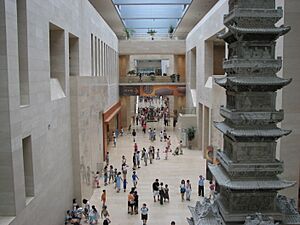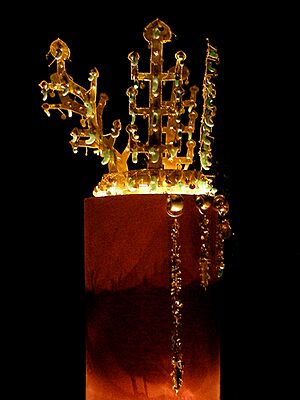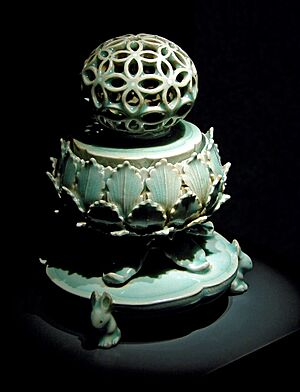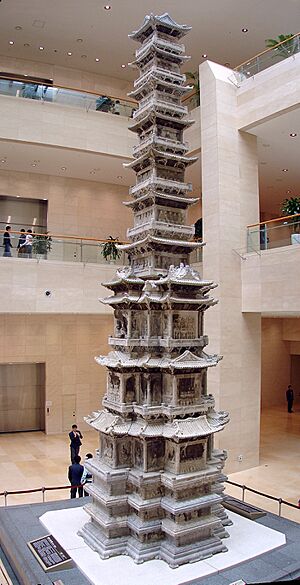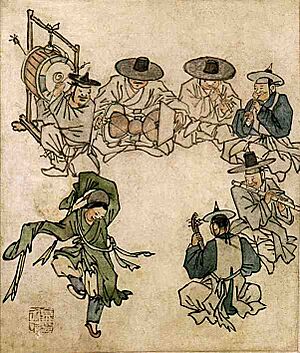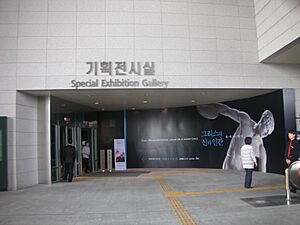National Museum of Korea facts for kids
| 국립중앙박물관 | |
 |
|

Front view
|
|
| Established | December 3, 1945 |
|---|---|
| Location | 137, Seobinggo-ro, Yongsan-gu, Seoul, South Korea |
| Type | History and Art museum |
| Collection size | over 310,000 pieces 295,551 square metres (3.18 million square feet) |
| Visitors | 3,788,785 (2024) |
| Public transit access | |
| National Museum of Korea | |
| Hangul |
국립중앙박물관
|
|---|---|
| Hanja | |
| Revised Romanization | Gungnip Jungang Bangmulgwan |
| McCune–Reischauer | Kungnip Chungang Pangmulgwan |
The National Museum of Korea (Korean: 국립중앙박물관) is the most important museum for Korean history and art in South Korea. It opened in 1945. Since then, the museum has studied and researched many things about archaeology, history, and art. It also creates different exhibitions and learning programs for visitors.
The museum moved to Yongsan District, Seoul in 2005. A new branch of the museum opened inside Incheon International Airport on June 24, 2021. This branch is in the airport's boarding area, near Gate No. 22. It opened to celebrate the museum's 20th anniversary.
Contents
- History of the National Museum
- Museum Layout and Galleries
- Museum Collection Highlights
- Gold Crown, National Treasure of Korea No. 191
- Pensive Bodhisattva
- Incense Burner, Celadon with Openwork, National Treasure of Korea No. 95
- Ten-Story Pagoda from Gyeongcheonsa Temple, National Treasure of Korea No. 86
- Album of Genre Painting by Danwon, Treasure of Korea No. 527
- The Oegyujanggak Uigwe: Royal Records
- See also
History of the National Museum
Korea's first museum was the Imperial Household Museum. Emperor Sunjong started it in 1909. The collections from this museum and another one from when Japan ruled Korea became the start of the National Museum's collection. This happened when South Korea became independent in 1945.
During the Korean War, the museum's 20,000 items were moved to Busan. This kept them safe from being destroyed. After the war, the museum returned to Seoul. It was housed in two palaces: Gyeongbokgung and Deoksugung Palace. In 1972, the museum moved again to a new building at Gyeonbokgung Palace.
The museum moved once more in 1986. It went into the Jungangcheong building. This building used to be the Japanese General Government Building. The museum stayed there until the building was taken down in 1995. In December 1996, the museum opened in a temporary spot. Then, it officially reopened in its current building in Yongsan Family Park on October 28, 2005.
The museum is located where a golf course used to be. This golf course was part of the Yongsan Garrison. That was the main base for US forces in Korea. The US Army gave some of the land back to the Korean government in 1992. This land became the Yongsan Family Park. Plans for the museum in the park started in 1993. However, its opening was delayed because of a helipad. The helipad was finally moved in 2005.
The museum has over 310,000 items in its collection. About 15,000 items are shown at one time. It displays old items and artifacts in six main galleries. These include the Prehistory and Ancient History Gallery and the Asian Art Gallery. The museum is the sixth largest in the world based on its floor space. It covers a total of 295,551 square meters.
To keep the artifacts safe, the main building was built to handle a magnitude 6.0 Richter Scale earthquake. The display cases have special platforms that absorb shocks. The museum also uses a natural lighting system. This system uses sunlight instead of artificial lights. There is also a special air-conditioning system. The museum is made from materials that resist fire. It has special exhibition halls, learning areas, and a children's museum. There are also large outdoor areas, restaurants, cafes, and shops.
Museum Layout and Galleries
The museum has three floors. The left side of the museum is meant to show the past. The right side represents the future. On the ground floor, you can find parks and gardens. There are also waterfalls and pools. You can see a collection of pagodas, stupas, and lanterns. This includes National Treasure of Korea No. 2, the Great Bell of Bosingak. This bell is a great example of Korean bells from the Joseon period.
First Floor Galleries
The first floor has the Prehistory and Ancient History Gallery. It holds about 4,500 artifacts. These items are from the Paleolithic (Old Stone Age) to the Unified Silla era. They were found at sites all over Korea. This gallery has nine rooms. They include the Palaeolithic Room, the Neolithic Room, and the Bronze Age Room. You can see items from chipped stone tools to fancy old royal jewelry. These items show how early people in Korea developed their unique culture.
Items from important old sites are in the Neolithic and Bronze Age Rooms. These include the Bangudae Petroglyphs and Songgung-ni.
Also on the first floor is the Medieval and Early Modern History Gallery. This gallery shows the culture and history from the Unified Silla, Balhae, Goryeo, and Joseon periods. It has eight rooms. These include the Unified Silla Room, Balhae Room, Goryeo Room, and the Joseon Room.
Second Floor Galleries
The second floor has the Donation Gallery and the Calligraphy and Painting Gallery. The Calligraphy and Painting Gallery has 890 art pieces. They show traditional and religious art from Korea. This gallery has four rooms: the Painting Room, the Calligraphy Room, the Buddhist Paintings Room, and the Sarangbang (Scholar's Studio).
The Donation Gallery displays 800 art pieces. These were given by private collectors. This gallery has eleven rooms. Each room is named after the collector who donated the items.
Third Floor Galleries
The third floor has the Sculpture and Crafts Gallery. It features 630 pieces of Korean Buddhist sculpture and craftwork. Important items here include Goryeo Celadon pottery. Also, there is National Treasure of Korea No. 83, Bangasayusang (Pensive Bodhisattva). This gallery has five rooms. They are the Metal Arts Room, the Celadon Room, and the Buddhist Sculpture Room.
Also on the third floor is the Asian Arts Gallery. It has 970 pieces. This gallery explores how Asian art is similar and different. It also shows how Asian and Western art mixed along the Silk Road. This gallery has five rooms. These include the Indian & Southeast Asian Art Room, the Chinese Art Room, and the Sinan Undersea Relics Room.
Museum Collection Highlights
Gold Crown, National Treasure of Korea No. 191
This gold crown is from the Fifth-century Silla kingdom. It was found in the North tomb of Hwangnamdaechong in Gyeongju. More ornaments were found in the North tomb than in the South tomb. This suggests the North tomb belonged to a woman. The gold crown shows the owner's high social standing.
Pensive Bodhisattva
This statue is from the early Seventh-century. It shows a Bodhisattva sitting with one leg crossed over the other. Its fingers are on its cheeks, as if deep in thought. This pose comes from the Buddha thinking about human life. The statue wears a flat crown. Its upper body is bare, with a simple necklace. This statue is very similar to a wooden Pensive Bodhisattva in Japan. It is likely that this statue was made in Silla. Its balanced shape and fine craftsmanship are typical of the Baekje period.
Incense Burner, Celadon with Openwork, National Treasure of Korea No. 95
This incense burner is from the Twelfth-century. It is a great example of Goryeo celadon pottery. It has three parts: a cover, a burner, and a stand. The cover has a hole in the middle for incense smoke to escape.
Ten-Story Pagoda from Gyeongcheonsa Temple, National Treasure of Korea No. 86
The "Gyeongcheonsa Ten-Story Pagoda" (경천사 십층석탑; 敬天寺十層石塔) was first built in 1348. It was at the Gyeongcheonsa monastery. In 1907, a Japanese official illegally took it to Japan. But it was returned in 1918 because British and American journalists asked for it. In 1960, it was put back at Gyoengbokgung Palace. However, it was hard to protect from acid rain. So, it was taken apart again in 1995. It was then moved inside the National Museum of Korea. It has been on display there since the museum reopened in 2005.
Album of Genre Painting by Danwon, Treasure of Korea No. 527
The 18th-century painter Kim Hong-do was also known as Danwon. He was famous for his funny and honest paintings of everyday people's lives. This album has twenty-five paintings. Each one focuses on people without much background. Kim's paintings look like sketches. But they show strong brush strokes and good balance. He likely developed this style in his late 30s. The album was probably finished when he was about 40 years old.
The Oegyujanggak Uigwe: Royal Records
Gyujanggak was a royal library. King Jeongjo, the 22nd ruler of Joseon, started it in 1776. It was on the grounds of Changdeokgung Palace. Over time, it also became a state research center. In 1782, another royal library called Oegyujanggak was built. It was on Gangwha Island. This was to keep important royal documents safer than in the capital.
Oegyujanggak held copies of writings, art, and drawings by past kings. It also had royal family trees and special books called uigwe. These uigwe were records of how to prepare for important royal events and ceremonies. They explained every step in detail. They also had beautiful hand-drawn pictures. These books helped future generations organize similar events. Uigwe started being made in the 15th century. This practice continued until the Joseon kingdom ended in the early 1900s. They show important parts of Confucian culture, which valued rituals. These works also show how the Joseon state was run. Their historical value is recognized worldwide. The "Royal Protocols of Joseon Dynasty" were added to the UNESCO Memory of the World Register in 2007.
Two hundred and ninety-seven volumes of these Protocols were taken in 1866. This happened during the French campaign against Korea. They were kept at the Bibliothèque nationale de France (National Library of France). In 1975, Dr. Park Byung-sun, who worked at the library, found these Joseon Dynasty books. She organized them, and their existence became known.
In September 1993, the French President visited Korea. He brought one volume of the "Huigyeongwonweonsodogam Uigwe." This showed his wish to return the Oegyujanggak books. However, the books were not returned as promised.
In October 2000, leaders from both countries met again. They agreed to lend 63 volumes to Korea. These were volumes that Korea did not have copies of. This was planned as a "cultural heritage exchange exhibition" by 2001. But the return talks were delayed by France. Also, groups in Korea wanted the books returned without any conditions. They even suggested going to the International Court of Justice.
The issue was not solved for a long time. However, at the G20 Summit on November 12, 2010, the presidents of both countries agreed. They decided to lend the Oegyujanggak books to Korea. This would be a five-year loan that could be renewed.
After 145 years, the books were finally returned in April and June 2011. They came back in four separate groups.
A special exhibition was held from July 19 to September 18, 2011. It was called The Return of the Oegyujanggak Uigwe from France: Records of the State Rites of the Joseon Dynasty. Before the exhibition, in June 2011, the museum showed five copies of the records to the media. They also showed the silk covers of other volumes.
See also
 In Spanish: Museo Nacional de Corea para niños
In Spanish: Museo Nacional de Corea para niños
- Ministry of Culture, Sports and Tourism


